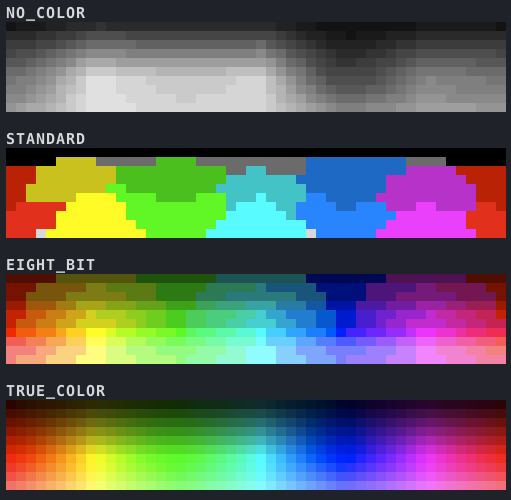A powerful terminal management library.
Project description
Slate
A powerful terminal management library.
pip install sh40-slate
Purpose
Slate handles most of the interactions one might be expected to
do while writing a UI application for terminals (TUI). It does so
in a simple to understand, Pythonic manner, and uses a simple
synchronous API to allow for maximum compatibility with existing
codebases.
Feature highlights
Screen API
Under the hood, Slate's terminal objects each have a Screen.
This screen is used for creating fast diffs of the display state
between renders, allowing you to draw only the parts that changed.
Anyone who's worked with terminals before knows their rendering is almost always the primary bottleneck of any application. They are surprisingly awful at rendering a full-screen's result, especially when clearing the display beforehand. Many applications result to hand-crafted update systems that only redraw the widgets that change, but that can still be quite intensive based on the size and content of each.
Slate handles cell-level diffing without you ever having to
think about it. You just draw content to the terminal, and we will
keep track of all the changes to display on the next draw, with
practically 0 performance hit.
import time
from random import randint
from slate import terminal, Span, Color
# Hide the terminal's cursor
terminal.show_cursor(False)
content = [
Span(
"X" * terminal.width,
bold=True,
foreground=Color.black().lighten(2),
background=Color.black(is_background=True).lighten(1),
)
for _ in range(terminal.height)
]
# Use an alt buffer to keep the pre-run terminal state intact
with terminal.alt_buffer():
for line in content:
terminal.write(content)
terminal.draw()
# Draw a '0' to a random spot on the screen, 60 times a second
#
# This type of operation is really taxing on terminals (especially old ones,
# like Terminal.app) as it generally is done by redrawing the entire screen.
# That's no longer gonna be a problem for us.
while True:
cursor = (randint(0, terminal.width - 1), randint(0, terminal.height - 1))
# Make sure no more than 1 cell changes; a sanity check for the most part,
# as this setup guarantees it.
assert terminal.write("0", cursor=cursor) <= 1
terminal.draw()
time.sleep(1 / 60)
Terminal's smart cursor
If you paid attention, you might have noticed that we never moved the terminal's cursor while drawing the initial lines of content. This is because the terminal will always track and move its own cursor when written to, so it knows when it ran out of space and needs to move to a new line.
from slate import terminal
print(terminal.cursor) # (0, 0)
terminal.write("1")
print(terminal.cursor) # (1, 0)
It will even wrap while writing!
from slate import terminal, getch
# It will even wrap while writing!
terminal.write("#" * (terminal.width - 5))
terminal.write("This is long, but it will wrap around to the next line.")
terminal.draw()
getch() # Wait for input so the shell prompt doesn't slide things out of view
Sophisticated color tools
You might have noticed the usage of the lighten and darken API for colors above. These are amongst the many tools we provide for working with colors, which also include blending, generating W3C guidelines compliant contrast colors (white for dark colors, black for light ones), generating entire 4-color palettes with multiple of the most commonly used strategies, and more.
Best part; it works everywhere. Colors get translated to the best approximation the current terminal can display, so you don't have to worry about things looking completely wonky without true color support. Most terminals (at least ones you should be using / targeting) have true color support nowadays, but our approximations will be good enough to use on older ones as well.
We also have advanced support for the NO_COLOR initiative, but instead of completely stripping the semantic information colors can convey, we translate each color to a greyscale value that matches with the perceived lightness, keeping the application informative.

Documentation
Once the library gets to a settled state (near 1.0), documentation will be hosted both online and as a celx
application. Until then peep the examples folder, or check out some of the references by using
python3 -m pydoc <name>.
See also
This library is mostly supposed to power some higher level tools, so using it raw might not be ideal. Thankfully, we have two projects that can help with that:
Project details
Release history Release notifications | RSS feed
Download files
Download the file for your platform. If you're not sure which to choose, learn more about installing packages.
Source Distribution
Built Distribution
Hashes for sh40_slate-0.7.0-py3-none-any.whl
| Algorithm | Hash digest | |
|---|---|---|
| SHA256 | 4d05275a1da3e361150dc505c3c250d39775c281da62ec796fc4391ebcbd77b8 |
|
| MD5 | dc854e54dd158fce9249c78c5904d93b |
|
| BLAKE2b-256 | 46a997a0cc6fb6e47a953f6a071f41c2abd476c10a6bcabb491bb7d200065561 |













